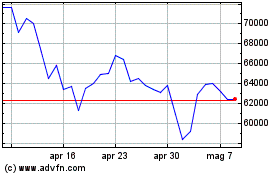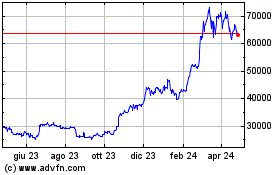Bitcoin’s Realized Cap Hits Record High—Is a Major Bull Run Brewing?
14 Febbraio 2025 - 4:30AM
NEWSBTC
Bitcoin has faced persistent challenges in recent weeks, struggling
to maintain a stable upward momentum. After recently slipping below
$100,000, the cryptocurrency now hovers around the $95,000 mark,
causing uncertainty among investors. Despite these setbacks, some
analysts see signs that the market’s bull cycle may still have room
to run. CryptoQuant contributor MAC_D recently examined the current
state of Bitcoin’s realized market capitalization, offering
insights into what might lie ahead for the asset. Related Reading:
Bitcoin’s Struggle Below $100K: Could These Market Signals Trigger
the Next Rally? Bitcoin Realized Cap as a Bullish Indicator
According to Mac’s analysis, Bitcoin’s realized market
capitalization—calculated by summing the value of each Bitcoin
based on its last recorded transaction price—has reached an
all-time high, surpassing $857 billion. This increase occurred even
as Bitcoin’s price experienced a downturn. Traditionally, a rising
realized cap indicates that coins are being sold by long-term
holders and absorbed by new investors. This redistribution cycle
often reflects a healthy, ongoing bull market rather than the end
of one. Mac noted that the proportion of long-term holders who have
held Bitcoin for more than six months currently stands at 39.74%,
compared to 15.66% during the previous market peak. This higher
percentage suggests that long-term holders remain active, and the
market has yet to reach its zenith. While the data indicates that
the bull cycle continues, external factors such as trade tensions
and inflation could still influence short-term corrections.
However, Mac believes these macroeconomic elements won’t derail the
market’s long-term upward trajectory. The analyst wrote: The
increase in realized market cap and the decrease in long-term
holder ratio indicate that the market is still in a bull cycle.
However, investors should also consider macroeconomic factors such
as trade tensions and inflation. While these factors may lead to
short-term corrections and periods of price stability, the
long-term upward trend is expected to persist. Retail Activity
Shows Signs of Revival In addition to realized cap metrics, other
market indicators also suggest potential positive developments.
Another CryptoQuant analyst, caueconomy, highlighted retail
investor behavior as a key factor to watch. While retail demand for
Bitcoin has been muted over the past month—declining by just 2%
compared to a steeper 20% drop in January—there are signs that this
normalization period is ending. Historically, increases in retail
activity have coincided with improved market sentiment and
short-term price rallies. If retail participation resumes, it could
strengthen Bitcoin’s market structure and contribute to a broader
recovery. Although Bitcoin’s current consolidation phase has
tempered its recent performance, these underlying metrics provide
some optimism for investors. Related Reading: Bitcoin OTC Balances
Decline, Raising Market Supply Questions The data suggests that
both long-term and retail participants remain engaged, setting the
stage for potential growth once the market regains momentum.
Featured image created with DALL-E, Chart from TradingView
Grafico Azioni Bitcoin (COIN:BTCUSD)
Storico
Da Gen 2025 a Feb 2025

Grafico Azioni Bitcoin (COIN:BTCUSD)
Storico
Da Feb 2024 a Feb 2025
